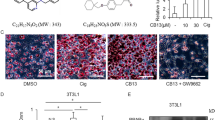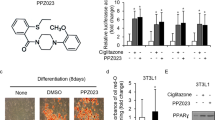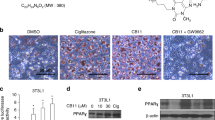Abstract
The peroxisome proliferator-activated receptor-gamma (PPAR-γ) is a member of the nuclear hormone receptor superfamily of ligand-activated transcription factors and a crucial regulator of cellular differentiation. Differentiation-inducing and antiproliferative effects of PPAR-γ suggest that PPAR-γ agonists might be useful as effective anticancer agents. Few studies have examined the efficacy of these agonists in animal models of tumorigenesis, and their mechanism(s) of action are still not clear. Our studies indicate higher PPAR-γ expression in primary tumors from non-small-cell lung cancer (NSCLC) patients when compared to normal surrounding tissue. The expression of PPAR-γ was also observed in several NSCLC lines. The treatment of lung adenocarcinoma cells (A549) with troglitazone (Tro), a PPAR-γ ligand, enhanced PPAR-γ transcriptional activity and induced a dose-dependent inhibition of A549 cell growth. The observed growth arrest was predominantly due to the inhibition of cell proliferation without significant induction of apoptosis. Cell cycle analysis of Tro-treated cells revealed a cell cycle arrest at G0/G1 with concomitant downregulation of G0/G1 cyclins D and E. In addition, Tro treatment stimulated sustained Erk1/2 activation in A549 cells, suggesting the activation of a differentiation-inducing pathway. Furthermore, treatment of A549 tumor-bearing SCID mice with Tro or Pio inhibited primary tumor growth by 66.7% and significantly inhibited the number of spontaneous lung metastatic lesions. Collectively, our data demonstrate that activation of PPAR-γ impedes lung tumor progression and suggest that PPAR-γ ligands may serve as potential therapeutic agents for NSCLC.
This is a preview of subscription content, access via your institution
Access options
Subscribe to this journal
Receive 50 print issues and online access
$259.00 per year
only $5.18 per issue
Buy this article
- Purchase on Springer Link
- Instant access to full article PDF
Prices may be subject to local taxes which are calculated during checkout







Similar content being viewed by others
References
Alarid ET, Bakopoulos N and Solodin N . (1999). Mol. Endocrinol., 13, 1522–1534.
Berger J and Moller DE . (2002). Annu. Rev. Med., 53, 409–435.
Bloch A . (1984). Cancer Treat Rep., 68, 199–205.
Chang TH and Szabo E . (2000). Cancer Res., 60, 1129–1138.
Desvergne B and Wahli W . (1999). Endocr. Rev., 20, 649–688.
Di-Poi N, Tan NS, Michalik L, Wahli W and Desvergne B . (2002). Mol. Cell, 10, 721–733.
El Khissiin A and Leclercq G . (1999). FEBS Lett., 448, 160–166.
Elstner E, Muller C, Koshizuka K, Williamson EA, Park D, Asou H, Shintaku P, Said JW, Heber D and Koeffler HP . (1998). Proc. Natl. Acad. Sci. USA, 95, 8806–8811.
Gurdon JB, Dyson S and St Johnston D . (1998). Cell, 95, 159–162.
Hauser S, Adelmant G, Sarraf P, Wright HM, Mueller E and Spiegelman BM . (2000). J. Biol. Chem., 275, 18527–18533.
Heaney AP, Fernando M, Yong WH and Melmed S . (2002). Nat. Med., 8, 1281–1287.
Jiang C, Ting AT and Seed B . (1998). Nature, 391, 82–86.
Kassam A, Hunter J, Rachubinski RA and Capone JP . (1998). Mol. Cell. Endocrinol., 141, 153–162.
Keshamouni VG, Mattingly RR and Reddy KB . (2002). J. Biol. Chem., 277, 22558–22565.
Kiyokawa H, Richon VM, Rifkind RA and Marks PA . (1994). Mol. Cell. Biol., 14, 7195–7203.
Kranenburg O, de Groot RP, Van der Eb AJ and Zantema A . (1995). Oncogene, 10, 87–95.
Krueger JS, Keshamouni VG, Atanaskova N and Reddy KB . (2001). Oncogene, 20, 4209–4218.
Kubota T, Koshizuka K, Williamson EA, Asou H, Said JW, Holden S, Miyoshi I and Koeffler HP . (1998). Cancer Res., 58, 3344–3352.
Lambe KG and Tugwood JD . (1996). Eur. J. Biochem., 239, 1–7.
Mandell JW, Hussaini IM, Zecevic M, Weber MJ and VandenBerg SR . (1998). Am. J. Pathol., 153, 1411–1423.
Marshall CJ . (1994). Curr. Opin. Genet. Dev., 4, 82–89.
Marshall CJ . (1995). Cell, 80, 179–185.
Mueller E, Sarraf P, Tontonoz P, Evans RM, Martin KJ, Zhang M, Fletcher C, Singer S and Spiegelman BM . (1998). Mol. Cell, 1, 465–470.
Nagy L, Tontonoz P, Alvarez JG, Chen H and Evans RM . (1998). Cell, 93, 229–240.
Nawaz Z, Lonard DM, Dennis AP, Smith CL and O'Malley BW . (1999). Proc. Natl. Acad. Sci. USA, 96, 1858–1862.
Nishida E and Gotoh Y . (1993). Trends Biochem. Sci., 18, 128–131.
Panigrahy D, Singer S, Shen LQ, Butterfield CE, Freedman DA, Chen EJ, Moses MA, Kilroy S, Duensing S, Fletcher C, Fletcher JA, Hlatky L, Hahnfeldt P, Folkman J and Kaipainen A . (2002). J. Clin. Invest., 110, 923–932.
Pierce GB and Speers WC . (1988). Cancer Res., 48, 1996–2004.
Ravi RK, Weber E, McMahon M, Williams JR, Baylin S, Mal A, Harter ML, Dillehay LE, Claudio PP, Giordano A, Nelkin BD and Mabry M . (1998). J. Clin. Invest., 101, 153–159.
Ricote M, Li AC, Willson TM, Kelly CJ and Glass CK . (1998). Nature, 391, 79–82.
Roovers RkAaK . (2000). BioEssays, 22, 818–826.
Sarraf P, Mueller E, Jones D, King FJ, DeAngelo DJ, Partridge JB, Holden SA, Chen LB, Singer S, Fletcher C and Spiegelman BM . (1998). Nat. Med., 4, 1046–1052.
Sarraf P, Mueller E, Smith WM, Wright HM, Kum JB, Aaltonen LA, de la Chapelle A, Spiegelman BM and Eng C . (1999). Mol. Cell, 3, 799–804.
Sherr CJ . (1994). Cell, 79, 551–555.
Shi Y, Hon M and Evans RM . (2002). Proc. Natl. Acad. Sci. USA, 99, 2613–2618.
Sivaraman VS, Wang H, Nuovo GJ and Malbon CC . (1997). J. Clin. Invest., 99, 1478–1483.
Spiegelman BM . (1998). Diabetes, 47, 507–514.
Spiegelman BM and Flier JS . (1996). Cell, 87, 377–389.
Syvala H, Vienonen A, Zhuang YH, Kivineva M, Ylikomi T and Tuohimaa P . (1998). Life Sci., 63, 1505–1512.
Tontonoz P, Hu E and Spiegelman BM . (1994). Cell, 79, 1147–1156.
Tontonoz P, Nagy L, Alvarez JG, Thomazy VA and Evans RM . (1998). Cell, 93, 241–252.
Wang C, Fu M, D'Amico M, Albanese C, Zhou JN, Brownlee M, Lisanti MP, Chatterjee VK, Lazar MA and Pestell RG . (2001). Mol. Cell. Biol., 21, 3057–3070.
Warrell Jr RP, Frankel SR, Miller Jr WH, Scheinberg DA, Itri LM, Hittelman WN, Vyas R, Andreeff M, Tafuri A and Jakubowski A . (1991). N. Engl. J. Med., 324, 1385–1393.
Watkins PB and Whitcomb RW . (1998). N. Engl. J. Med., 338, 916–917.
Zhu J, Gianni M, Kopf E, Honore N, Chelbi-Alix M, Koken M, Quignon F, Rochette-Egly C and de The H . (1999). Proc. Natl. Acad. Sci. USA, 96, 14807–14812.
Acknowledgements
We thank Dr Todd Leff (Wayne State University, Detroit, MI, USA) for providing PPRE-tk-Luc and tk-Luc plasmids, Sarah Alousie (Wayne State University, Detroit, MI, USA) for technical help with Immunohistochemistry, and members of the Flow cytometry core facility (University of Michigan Comprehensive Cancer Center, Ann Arbor, MI, USA) for flow cytometric analysis. VG Keshamouni is a Parker B Francis Fellow in Pulmonary Research. This research is supported by funds from NIH Grants P050 HL60289, HL57243 (TJS), and K08 HL070068 (RCR) and American Lung Association Grant RG-134-N (VGK).
Author information
Authors and Affiliations
Corresponding author
Rights and permissions
About this article
Cite this article
Keshamouni, V., Reddy, R., Arenberg, D. et al. Peroxisome proliferator-activated receptor-γ activation inhibits tumor progression in non-small-cell lung cancer. Oncogene 23, 100–108 (2004). https://doi.org/10.1038/sj.onc.1206885
Received:
Revised:
Accepted:
Published:
Issue Date:
DOI: https://doi.org/10.1038/sj.onc.1206885
Keywords
This article is cited by
-
Diabetes medications and cancer risk associations: a systematic review and meta-analysis of evidence over the past 10 years
Scientific Reports (2023)
-
The influence of conjugated linoleic acid on the expression of peroxisome proliferator-activated receptor-γ and selected apoptotic genes in non-small cell lung cancer
Molecular and Cellular Biochemistry (2020)
-
Anticancer properties of 5Z-(4-fluorobenzylidene)-2-(4-hydroxyphenylamino)-thiazol-4-one
Scientific Reports (2019)
-
The α-melanocyte stimulating hormone/peroxisome proliferator activated receptor-γ pathway down-regulates proliferation in melanoma cell lines
Journal of Experimental & Clinical Cancer Research (2017)
-
Peroxisome proliferator activated receptor γ protein expression is asymmetrically distributed in primary lung tumor and metastatic to lung osteosarcoma samples and does not correlate with gene methylation
BMC Veterinary Research (2015)



